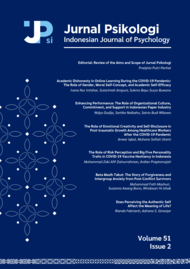Perundungan Reaktif di Sekolah Dasar dan Intervensi Berbasis Nuansa Sekolah
Arina Mufrihah(1*)
(1) Program Studi Bimbingan dan Konseling, STKIP PGRI Sumenep Pusat Studi Gender dan Anak (PSGA) STKIP PGRI Sumenep
(*) Corresponding Author
Abstract
Full Text:
PDFReferences
Beattie, R Mark. (2015). Long-term effects of bullying. Archieve of Disease in Childood, 100(9i). DOI: 10.1136/archdischild-2015-309491. Burton, K. Alex., Florell, Dan., & Gore, Jonathan S. (2013). Differences in Proactive and Reactive Aggression in Traditional Bullies and Cyberbullies. Journal of Aggression, Maltreatment & Trauma, 22(3), 316-328. DOI: 10.1080/10926771.2013.743938. Camodeca, M., Goossens, F. A., Terwogt, M. M., & Schuengel, C. (2002). Bullying and Victimization Among School-age Children: Stability and Links to proactive and Reactive Aggression. Social Development, 11(3), 332-345. DOI: 10.1111/1467-9507-00203. Cook, C. R., Williams, K. R., Guerra, N. G., Kim, T. E., & Sadek, S. (2010). Predictors of bullying and victimization in childhood and adolescence: A meta-analytic investigation. School Psychology Quarterly, 25(2), 65. Creswell, John. (2006). Choosing A Mixed Method Design. Sage: Thousand Oaks. Dedousis-Wallace, Anna., Shute, Rosalyn., Varlow, Megan., Murrihy Rachael., & Kidman, Tony. (2014). Predictor of teacher intervention in indirect bullying at school and outcome of a professional development presentation for teachers. Educational Psychology, 34(7), 862-875. DOI: 10.1080/01443410.785385. Gibson, R. L., & Mitchell, M. H. (2010). Bimbingan dan Konseling. Yogyakarta: Pustaka Pelajar. Gini, Gianluca., & Pozzoli, Tiziana. (2006). The Role of Maculinity in Children's Bullying. Sex Roles, 54(7), 585-588. DOI: 10.1007/s11199-006-9015-1. Golmaryami, Farrah N., Frick, Paul J., Hemphill, Sheryl A., Kahn, Rachel E., Crapanzano, Annie M., & Terranova, Andrew M. (2016). The Social, Behavioral, and Emotional Correlates of Bullying and Victimization in a School-Based Sample. Journal of Abnormal Child Psychology, 44(2), 381-391. DOI: 10.1007/s10802-015-9994-x. Goodman-Scott, Emily., Doyle, Beth., & Brott, Pamelia. (2013). An Action Research Project to Determine the Utility of Bully Prevention in Positive Behavior Support for elementary School Bullying Prevention. Professional School Counseling, 17(1) 120-129. DOI: 10.5330/prsc.17.153346473u5052044. Healy, Karyn L., Sanders, Matthew R., & Lyer, Aarti. (2015). Parenting Practices, Children's Peer Relationships and Being Bullied at School. Journal of Child and Family Studies, 24(1), 127-140. DOI: 10.1007/s10826-013-9820-4. Hong, J.S., & Espelage, D.L., (2012). A review of research on bullying and peer victimization in school: An ecological system analysis. Aggression and Violent Behavior, 17(4), 311-322. DOI: 10.1016/j.avb.2012.03.003. Hong, J. S., Peguero, A. A., Choi, S., Lanesskog, D., Espelage, D. L., & Lee, N. Y. (2014). Social ecology of bullying and peer victimization of Latino and Asian youth in the United States: a review of the literature. Journal of School Violence, 13(3), 315–338. Huang, Hui., Hong, Jun Sung., & Espelage, Dorothy L. (2013). Understanding Factors Associated with Bullying and Peer Victimazation in Chinese Schools Within Ecological Contexts. Journal of Child and Family Studies, 22(7), 881-892. DOI: 10.1007/s10826-012-9647-4. Juvonen, Jaana., & Graham, Sandra. (2014). Bullying in School: The Power of Bullies and the Plight of Victims. Annual Review of Psychology, 65, 159-185. DOI: 10.1146/annurev-psych-010213-115030. Majcherova, Katarina., Hajduova, Zuzana., & Andrejkovic, Marek. (2014). The role of the school in handling the problem of bullying. Aggression and Violent Behavior, 19(5), 463-465. DOI: 10.1016/j.avb.2014.06.003. McAdams, C. R., & Schmidt, C. D. (2007). How to Help a Bully; Recommendation for Counseling the Proactive Aggressor. ASCA Professional School Counseling, 11:2, Desember, 120-128. Milsom, A., & Gallo, L. L. (2006). Bullying in Middle Schools: Prevention and Intervention. Middle School Journal (J1), 37(3), 12–19. Morcillo, Carmen., Ramos-Olazagasti, Maria A., Blanco, Carlos., Sala, Regina., Canino, Glorisa., Bird, Hector., & Duarte, Cristiane S. (2015). Socio-Cultural Context and Bullying Others in Childood. Journal of Child and Family Studies, 24(8), 2241-2249. DOI: 10.1007/s10826-014-0026-1. Morrow, Michael. T., Hubbard, Julie A., & Swift, Lauren E. (2014). Relations Among Multiple Types of Peer Victimization, Reactivity to Peer Victimization, and Academic Achievement in Fifth-Grade Boys and Girls. Merill-Palmer Quarterly, 60(3), 302-327. Notosoedirdjo, M., & Latipun. (2007). Kesehatan Mental; Konsep dan Penerapan. Malang: UMM Press. Olweus, Dan., & Breivik, Kyrre. (2014). Plight of Victims of School Bullying: The Opposite of Well-Being. Handbook of Child Well-Being, 15, 2593-2616. DOI: 10.1007/978-90-481-9063-8-100. Puhl, Rebecca M., & King, Kelly M. (2013). Weight Discrimination and Bullying. Best Practice & Research Clinical Endocrinology & Metabolism, 27(2), 117-127. DOI: 10.1016/j.beem.2012.12.002. Sciarra, D. T. (2004). School Counseling; Foundations and Contemporary Issues. USA: Thompson Learning, Inch. Toblin, Robin L., et. all. (2005). Social-cognitive and behavioral attributes of aggressive victims of bullying. Journal of Applied Developmental Psychology, 26(3), 329-346. Taylor, S. E. (2006). Health Psychology. New York: McGraw-Hill. Veenstra, Rene., Verlinden, Marina., Huitsing, Gijs., Verhulst, Frank C., & Tiemeier, Henning. (2013). Behind bullying and defending: same-sex and other-sex relations and their associations with acceptance and rejection. Aggressive Behavior, 39(6), 462-471. DOI: 10.1002/ab.21495. Yang, An., & Salmivalli, Christina. (2013). Different forms of bullying and victimization: Bully-victims versus bullies and victims. European Journal of Developmental Psychology, 10(6), 723-738. DOI: 10.1080/17405629.2013.793596. Zwierzynska, Karolina., Wolke, Dieter., & Lereya, Tanya S. (2013). Peer Victimization in Childood and Internalizing Problems in Adolescence: A Prospective Longitudinal Study. Journal of Abnormal Child Psychology, 41(2), 309-323. DOI: 10.1007/s10802-012-9678-8.
Article Metrics
Refbacks
- There are currently no refbacks.
Copyright (c) 2017 Jurnal Psikologi

This work is licensed under a Creative Commons Attribution-ShareAlike 4.0 International License.
Recent Issues
 |  |  |  | ||||
| Vol 51 Issue 2 (2024) Page 120-230 | Vol 51 Issue 1 (2024) Page 1-119 | Vol 50 Issue 3 (2023) Page 219-332 | Vol 50 Issue 2 (2023) Page 125-218 |
| Published by Faculty of Psychology, Universitas Gadjah Mada, Indonesia Building D-6th, Floor No. D-606. Jl. Sosio Humaniora No. 1, Bulaksumur Yogyakarta, 55281 Email: jurnalpsikologi@ugm.ac.id Phone/whatsApp: +6281125210175 |











